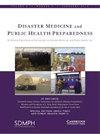Utilization of the Disaster Medical Assistance Team (DMAT) in an Inner-City Emergency Department During the COVID-19 Pandemic
IF 1.9
4区 医学
Q3 PUBLIC, ENVIRONMENTAL & OCCUPATIONAL HEALTH
引用次数: 0
Abstract
Objective: To evaluate the effect of the Disaster Medical Assistance Team (DMAT) in an inner-city emergency department during the coronavirus disease (COVID-19) pandemic. Methods: Data were abstracted from individual emergency department encounters over 6 weeks. The study compared left without being seen (LWBS) percentage, door-to-provider, and door-to-disposition times for 2 weeks before, during, and after the DMAT. Results: The LWBS percentages for the 2 weeks before and after the DMAT were 16.2% and 11.6%, respectively. The LWBS percentage during the DMAT was 8.1%. Door-to-disposition times for the 2 weeks before and after the DMAT were 7.36 hours and 8.53 hours, respectively. The door-to-disposition during the DMAT was 7.33 hours. Door-to-disposition was statistically significant during the 2 weeks of the DMAT compared to the 2 weeks after the DMAT (7.33 vs 8.53,在 COVID-19 大流行期间,内城急诊科利用灾难医疗援助队 (DMAT) 的情况
目的评估冠状病毒病(COVID-19)大流行期间灾难医疗援助队(DMAT)在市内急诊科的作用。方法:从急诊科的个人病例中抽取数据,并对数据进行分析:从急诊科 6 周内的个人就诊情况中抽取数据。研究比较了 DMAT 启用前、启用期间和启用后 2 周内未就诊的患者(LWBS)比例、患者到达医疗机构的时间以及患者到达医院的时间。结果:在 DMAT 之前和之后的两周内,未就诊百分比分别为 16.2% 和 11.6%。在 DMAT 期间,LWBS 百分比为 8.1%。DMAT 前后两周的门到处置时间分别为 7.36 小时和 8.53 小时。在 DMAT 期间,门到处置时间为 7.33 小时。与DMAT之后的两周相比,DMAT期间的门到处置时间具有统计学意义(7.33 vs 8.53,P <0.05),但与DMAT之前的两周相比,门到处置时间没有统计学意义(7.36 vs 7.33,P = 1.00)。与DMAT前(114.54分钟[1.91小时])和DMAT后(102.84分钟[1.71小时])相比,DMAT期间从门口到提供者的时间最长(122.5分钟[2.04小时])。结论DMAT 对 LWBS 百分比的影响最为积极。在研究中,DMAT 没有改善从门诊到提供者的时间,而仅改善了从门诊到处置的时间(将 DMAT 出现的时间与 DMAT 离开后的时间进行比较)。
本文章由计算机程序翻译,如有差异,请以英文原文为准。
求助全文
约1分钟内获得全文
求助全文
来源期刊

Disaster Medicine and Public Health Preparedness
PUBLIC, ENVIRONMENTAL & OCCUPATIONAL HEALTH-
CiteScore
4.40
自引率
7.40%
发文量
258
审稿时长
6-12 weeks
期刊介绍:
Disaster Medicine and Public Health Preparedness is the first comprehensive and authoritative journal emphasizing public health preparedness and disaster response for all health care and public health professionals globally. The journal seeks to translate science into practice and integrate medical and public health perspectives. With the events of September 11, the subsequent anthrax attacks, the tsunami in Indonesia, hurricane Katrina, SARS and the H1N1 Influenza Pandemic, all health care and public health professionals must be prepared to respond to emergency situations. In support of these pressing public health needs, Disaster Medicine and Public Health Preparedness is committed to the medical and public health communities who are the stewards of the health and security of citizens worldwide.
 求助内容:
求助内容: 应助结果提醒方式:
应助结果提醒方式:


